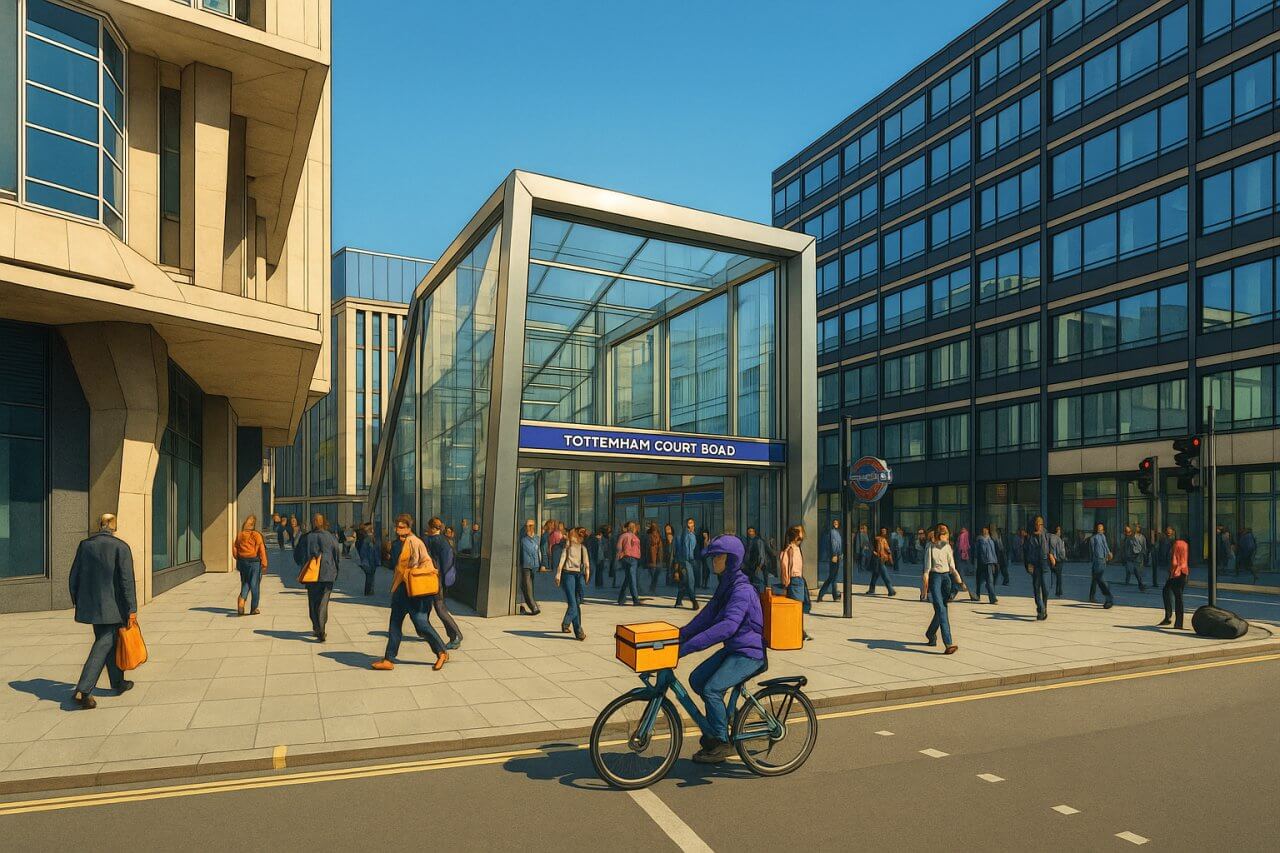
Tottenham Court Road Station, London
Tottenham Court Road Station is a major London Underground interchange located in the heart of the West End, at the intersection of Tottenham Court Road and Oxford Street. The station serves as a critical hub for commuters, shoppers, theatre-goers, and tourists, offering access to multiple Underground lines and a direct link to the Elizabeth line.
Location and Entrances
The main entrance to Tottenham Court Road Station is situated at Oxford Street near its junction with Tottenham Court RoadCharing Cross Road and Dean Street. A significant surface-level entrance building was constructed as part of the Crossrail (Elizabeth line) redevelopment and also features street-level retail spaces.
This station lies approximately 0.7 miles northwest of Charing Cross by road, a walkable distance for those navigating central London on foot.
Lines and Services
Tottenham Court Road Station is served by three major rail services:
- London Underground
- Elizabeth line (part of the TfL Rail network)
London Underground Services
The Underground services include the Central line and the Northern line:
- Central line: Preceding station: Oxford Circus; Subsequent station: Holborn
- Northern line (Charing Cross branch): Preceding station: Leicester Square; Subsequent station: Goodge Street
Elizabeth Line Services
Since the opening of the Elizabeth line in May 2022, Tottenham Court Road has become a key stop on the high-frequency east-west cross-London rail route. It provides rapid connections to:
- Paddington and the west, including Heathrow Airport
- Canary Wharf and the East End
- Key interchanges such as Farringdon and Liverpool Street
Station History
Tottenham Court Road Station originally opened on 22 June 1907 on the Charing Cross, Euston and Hampstead Railway—today part of the Northern line. The Central London Railway (now the Central line) platforms followed shortly thereafter, opening on 30 July 1900. However, the two lines were not interconnected until decades later.
The station underwent major redevelopment in the early 21st century as part of the Crossrail project. The expansion included new ticket halls, step-free access, enhanced interchange capacity, and public art installations. The redesigned station was unveiled in stages between 2010 and 2022.
Origin of the Name
The station is named after Tottenham Court Road, the major shopping street it serves. The road itself derives its name from a manor called “Tottenhall” that once existed in the area. The station has always borne this name since its inception, aligning with the traditional London Underground practice of using nearby landmarks or roads for station naming.
Architectural Features and Public Art
In recent years, Tottenham Court Road Station has become known not just for its utility, but also for its visual impact. The upgrade introduced eye-catching art by British artist Daniel Buren and preserved surviving mosaics by Eduardo Paolozzi, which had become iconic in the earlier station design.
Paolozzi's vibrant mosaics, originally installed in the 1980s, were inspired by pop culture, electronics, and musical influences, perfectly suiting the area’s lively character. While much of his work was removed during construction, parts of it have been carefully restored and reinstalled at key points within the station.
Fun Fact
A lesser-known fact about Tottenham Court Road Station is its connection to the Harry Potter universe. In "Harry Potter and the Deathly Hallows", Harry, Ron, and Hermione escape to Tottenham Court Road after fleeing from Bill and Fleur’s wedding, highlighting the station’s cultural significance beyond its transit function.
Accessibility and Facilities
Today, the station is fully step-free and equipped with escalators and lifts serving all lines. It features modern ticket machines, extensive signage, digital information boards, and retail units at ground level. As part of TfL’s commitment to accessibility, Tottenham Court Road ranks among the best-connected stations in central London.
Nearby Attractions
Tottenham Court Road Station is ideally located for visitors heading to:
- Oxford Street – One of the world's busiest shopping streets
- Soho – A nightlife, dining, and entertainment hotspot
- The Dominion Theatre – Directly adjacent to the station
- The British Museum – About a 10-minute walk away
This proximity to central London landmarks makes the station a popular arrival and departure point for both tourists and Londoners.
Quick Facts
- Opened: 22 June 1907 (Northern line); 30 July 1900 (Central line)
- Lines Served: Central, Northern (Charing Cross branch), Elizabeth line
- Location: Junction of Oxford Street and Tottenham Court Road
- Nearby Streets: Oxford Street, Charing Cross Road, Dean Street
- Distance from Charing Cross: 0.7 miles by road
- Accessibility: Fully step-free with lifts and escalators
- Main Attractions Nearby: British Museum, Soho, Oxford Street, Dominion Theatre
- Fun Fact: Featured in "Harry Potter and the Deathly Hallows"
- Architectural Feature: Restored Paolozzi mosaics and modern design by Hawkins\Brown
References
- Transport for London – Tottenham Court Road Station
- Crossrail – Tottenham Court Road
- Londonist – Tottenham Court Road Station Revamp
- The Guardian – Paolozzi Mosaics
Tottenham Court Road Station is  on the Map of London Underground
on the Map of London Underground

Painting of Tottenham Court Road Station, London (View image in full size)